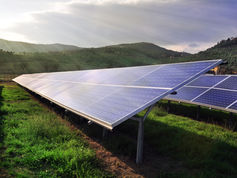The DRC's Copper Potential
- Ray Mwareya
- Oct 1
- 3 min read
Namib Minerals is excited about its stock, with 19.8 million shares traded on its IPO debut on 1 August. However, its chief executive tells the Energy Pioneer that, whilst gold is Namib’s primary focus, its recent foray into the DRC’s copper is borne out of the belief that "the DRC is still hugely under-explored."
Congo is copper
The energy transition demand for copper is massive, Ibrahima Tall explains. Namib Minerals has gone proactive – and has been given four years of exclusivity to explore mining possibilities under its permits in the Democratic Republic of the Congo (DRC).
Current drilling in the DRC has identified copper mineralization in intervals up to 3.28% copper within 150 meters of surface – for environmental technicians like Shamiso Mupara – that depth is impressively close to the surface.
“Honestly, it’s going to be very hard for any other country to beat the DRC any time soon when it comes to supplying copper”, Tall says.
What makes copper so crucial to the global energy transition is that the metal is used in solar panels, wind turbines, power cables, and electrical wiring, writes Shaik Ejamani Peer Mohamed, Senior Consultant for Power Cables at Det Norske Veritas, the Norwegian energy insurance practice. Additionally, electricity demand for household and industrial use is expected to rise annually from 25 Mt currently to 36.6 Mt by 2031. With a supply forecast of 30.1 Mt, the global copper shortage looms.
Going broke for copper
In its search for new energy metals, particularly copper, Namib Minerals is not afraid to take risks, as its early drilling in the Congo is promising.
Although Tall can’t say where the next ‘big copper’ discovery will be located between Botswana, Zambia, and the DRC, it will be very hard for any other country in the world to surpass the DRC's achievements anytime soon, as demand for energy transition metals soars. The Congo, accounting for 2.5 Mt annually, has climbed to the third-largest producer of copper globally, behind Peru and Chile, according to Statistics Canada.
The Congo is also a country where the Trump administration is aggressively imposing a ‘peace deal’ in exchange for American companies getting preferential access to copper, cobalt, lithium, and other rare earth metals central to EVs and decarbonization. The Lobito Atlantic Railway, 1,280 km west to the Atlantic Ocean, began shipping copper cathodes bound for Baltimore from the Congo in August 2024, a win for the Biden administration's strategic positioning in the region.
Headwinds
However, as the global energy industry eyes Congo’s copper riches, a wave of resource nationalism is sweeping across Africa, causing friction for Western miners.
For example, Mali seized gold from Barrick, a Canadian company; Botswana is demanding that De Beers renegotiate historic diamond revenue-sharing agreements; Zimbabwe is demanding that miners make plans to build domestic refineries (and is setting up its sovereign companies, such as the Mutapa Investment Fund, to increase the state's involvement in the gold sector. Though the Congo has some refinery capacity, the majority of its raw copper is shipped to China for final processing.
“Resource nationalism reflects a broader trend of countries wanting to see more value created at home, and governments have every right to set these priorities,” Tall says.

Namib Minerals fully respects and supports such decisions. Importantly, the company is African-led and managed, he emphasizes.
“We see ourselves not just as extractors, but as partners in building long-term value. That means aligning with national development goals, whether through local processing, skills development, or ensuring communities benefit from our presence,” he says.
Listing controversies
Resource nationalism across Africa has also led to the criticism of mining companies that prefer to be listed on Western stock exchanges in London or New York. This has led to a decline of listed companies and badly needed capital in South Africa as some gold and copper miners flee the Johannesburg Stock Exchange – Africa’s largest – for the NYSE, London, or Australia’s bourses.
Why did Namib choose Nasdaq instead of listing closer to its operations in South Africa, for example?
“Listing on Nasdaq gives us broader global exposure and access to a deep pool of international investors,” Tall says bluntly.
He reveals the immediate impact the Nasdaq IPO has brought – 19.8 million shares of Namib Minerals were traded in a single day, the largest trading volume across the exchange. “It’s remarkable. We are gaining traction,” he says.













Comments